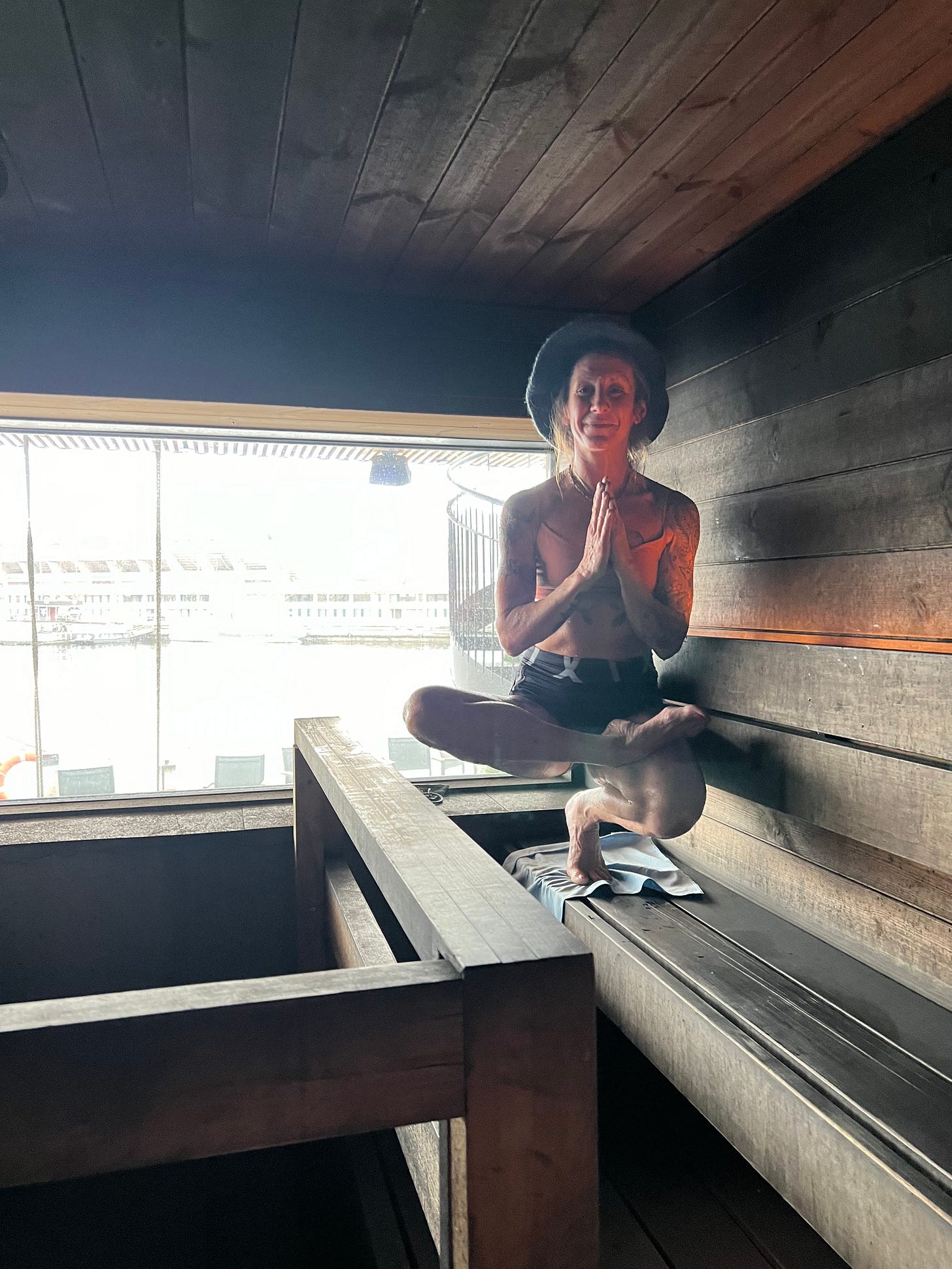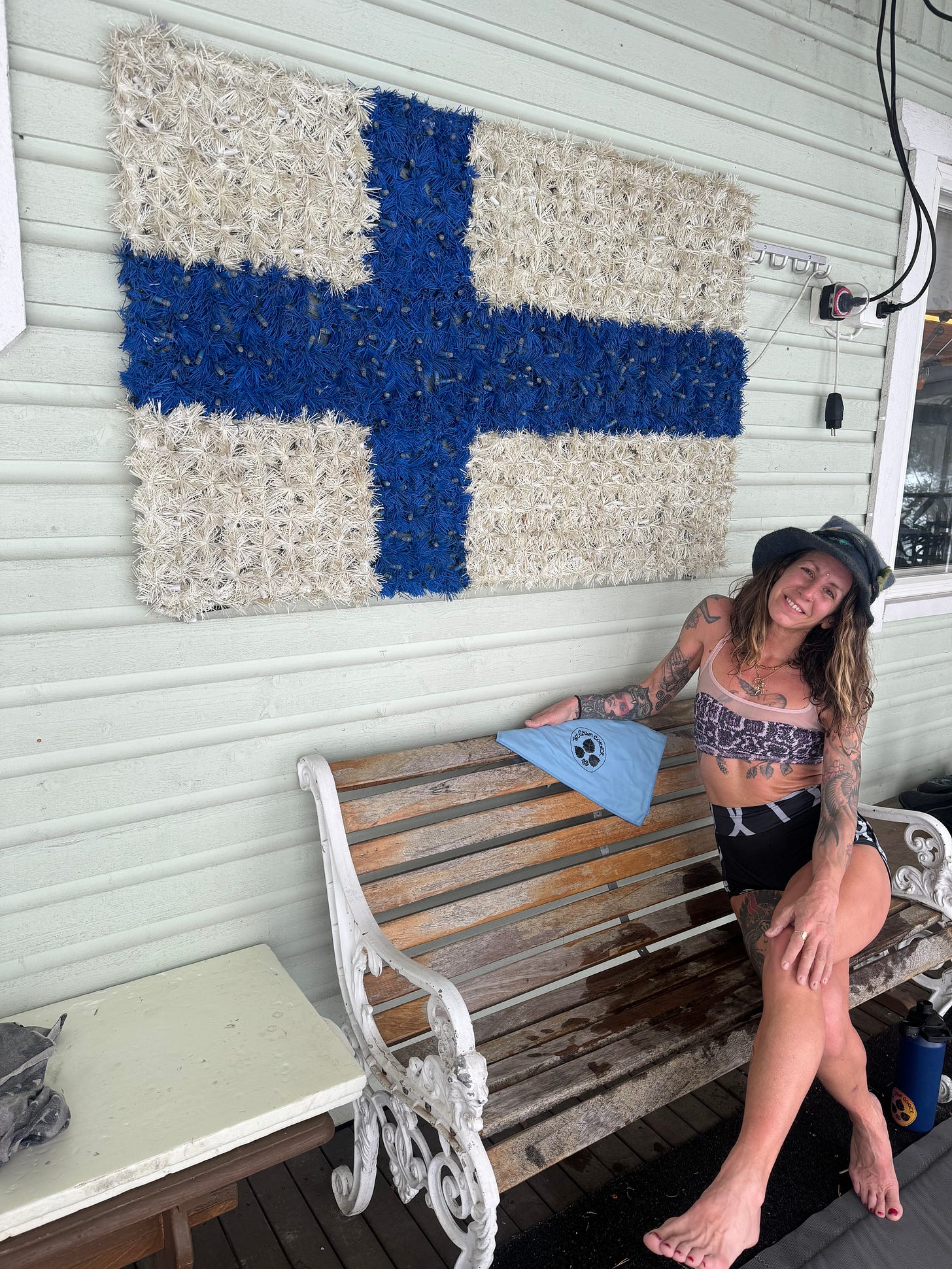The power of hot and cold to calm
Temperature extremes to quiet the mind and why winter is officially sauna season
Wellness coach and sauna master, Jesse Devlin (pictured above with sauna hat and leaf whisk), describes her journey from cold showers and hot yoga to running the Slomo contrast bathing site in Christchurch. She also tells how temperature extremes have helped her grab life by the horns.
How did you find your way into contrast bathing?
I was trained to be a mental health nurse and then I was a teacher for kids with quite severe mental health problems. And through that really intense job one of the therapists said, “Oh, my God, you've got to come and try this Bikram yoga.”
So as someone with a very stressful job, who was very busy – and I've since been diagnosed with ADHD – I discovered the power of the heat. For the first time ever, I felt like this is my whole self immersed in the moment when doing something that requires that much intensity.
It was at a similar time I also got into having cold showers and I discovered the same thing. So I realised there's something about intensity that is really powerful – whether you've got an overactive mind or you're super busy, or stressed, or maybe tending to not feel that great.
And you went on to work in a sauna in Brighton?
After a time teaching Bikram yoga, yes. I wasn't really that drawn to sauna. I was just really fascinated and passionate about how the heat affected the body’s mental and physical processes.
And being a bit of a natural entrepreneur and so passionate about wellness, over the summer when I was working there I was thinking you could be getting people down here in the morning, at sunrise, and doing some yoga, and then getting in the sea and then getting into the sauna, and then you could be leading a bit of meditation and pampering people a bit in the sauna. It was all based on these practices that I passionately felt had helped my mental health. And that is how Inferno Wellness, my brand, was born.
Why saunas in particular?
Even though I've discovered these different elements of hot and cold and yoga and meditation and movement all separately, I felt like the sauna brought up this space where we could bring all these amazing things together.
You're in a space where you're connected with others, you're doing these exhilarating practices together. There's an element of mindfulness, of meditation, it's the yogic philosophy about slowing down and treating yourself well and honoring what's enough for you and it not being competitive.
Instead of thinking, “Oh, I've got to go and do this thing, but I can't be bothered”, I would just do it.
It's super exciting. And now I'm realising we can make it whatever we want to make it, whether it's a mental health focus, a women's focus, something about the moon, something to do with yoga, something to do with men's mental health. You can bring in so many facets. And I feel like the sauna as a space to do those practices is the gift that keeps on giving.

What kind of benefits has it all had for you?
For me, what I have found most powerful are the psychological benefits because, when your mind gives you a lot of chat all the time, it has helped to have a practice that kind of just silences that. And it requires a degree of resilience and a degree of discipline to put yourself through these practices that can be quite intense – it's actually a little bit like work.
What I found, especially when I was doing the cold part of the practices, is once you begin to do this on a regular basis, you have far less resistance to the other stuff in your life that you maybe don't want to do or can't be bothered to do.
When I first got into it, I noticed instead of thinking, “Oh, I've got to go and do this thing, but I can't be bothered”, I would just do it. And I realised that there's a correlation – if you can wake up and go and put yourself in a cold bath, or if you can go and do a 90-minute Bikram yoga class every day, you can kind of do anything.”
And what were you seeing in terms of benefits for others?
Similarly, I found people talking about the psychological benefits. When I was doing these sunrise sessions in Brighton and the client group just got bigger and bigger and bigger, I started to realise how much they were talking and how much the sessions had changed their lives. It was really like “wow” for me.
They were saying things like, having come to these sessions they were more able to cope with the rest of their lives. And you realise everybody is carrying stuff, whether it's to do with their children, their partnership, their business, everyone is carrying loads of stress.
I feel like sauna in the summer is lovely, in the winter it’s full power.
These women – predominantly, because men would come, but the women would come back time and time again – were having this space at the start of their day, completely removed from everything in the house, in their life. It gave them this space to move their body [during the yoga] – so to move a lot of emotion – and to engage in these hot and cold practices which were really quite exhilarating. And maybe [after the movement and practices] they had a bit more space in their mind so they were able to talk about what was going on in their lives. And I realised that that's why it was like therapy.
What is it like using a sauna in winter?
Winter is officially sauna season! The colder it is already, the more enjoyable the sauna session is because you're in this toasty, hot box and when you step back outside into those wintery climes, you've just been immersed in 90 degree heat for maybe 15 to 20 minutes. It's just glorious. You don't feel the cold in the same way you would stepping outside your house.
And we think we want to be hot, but what we want is relief, normally. We want to be hot, but then as soon as we’re hot we want that relief of the cold.
When you do sauna in winter and it's cold outside there's more sweet relief involved, because you when you arrive and you’re cold it's lovely to get in the hot sauna. But then when you step out for your cold break, it's an even colder break, it's even more exhilarating. The water’s colder, the brain chemicals are more flowing. It feels more exhilarating standing out in a wintery landscape just in your swimwear.
I feel like sauna in the summer is lovely, in the winter it’s full power.
How has it been working in Christchurch?
What’s wonderful about Christchurch is it is this little self-contained sauna garden. Almost like a little retreat in itself. People were coming, finding their way there, into the depths of this boat yard in Christchurch. And then it has been like a little escape from people's day-to-day lives – you've got the saunas, you've got all these cold bathing facilties, and then you've got the river with the boats passing. It is one of the most beautiful sauna spots I've seen.
What is leaf whisking?
The best way to think about leaf whisking is it's a way to move the air around in the sauna. The first saunas would have been made in caves underground and the primitive people using these saunas would have realized the steam is rising to the ceiling and we need to get it down. So they would have gone out and foraged leaves and branches to make something like a broom or like a bunch of branches that is used to wave that hot air down.

Everybody's a sauna master. Everybody can do this. But when you're skilled and trained in it, you can use these leaves to manipulate the air so you can give each individual bather almost like their own little five or 10 minutes of personal steam.
And then these lovely leaves become warm themselves. So you can touch the body and press them on the body in different ways, which feels beautiful and has loads of physical benefits.
People think we just use them to swat the skin, but there's so much more than that. We use them to move the air, to gently bring different sensation to the skin. We can hold them on the heart as like a hot compress. We can swat the back, which is amazing for the muscles and feels great.
Losing yourself in a sauna is one thing, but having a leaf whisking treatment, it just takes it to another level.
And what is the purpose of the sauna hat you are wearing in the photos?
The hat is basically a layer of felt made from sheep’s wool that's covering your head. People think wearing a hat would make you more hot. But what it’s doing is, if you’re working in the sauna, it’s creating a little pocket of air around your head and protecting your head and your hair and your brain and your scalp from being exposed to the hot steam, and allowing you to stay in the sauna longer.
And when you step out of the sauna, it's keeping that heat in, and it's allowing you to be outside and able to take the cool a bit more.
What advice would you give your teenage self?
If I could go back to my teenage self, I would hope they discovered the powerful effects of the elements and nature way back then, realising that dopamine is not at the bottom of a beer bottle.
In a nutshell, I would say go and find natural highs.
What is your favourite food?
I spent years as a vegan and vegetarian and when I went to Finland and saw people eating sausages between the sauna rounds, I kind of couldn't believe it. Since I've come back, it's changed my view of sauna – is the sauna the same if you don’t have a grilled sausage in between?
So I’ll say something very Finnish sauna; nothing beats a sausage off the grill in between sauna rounds.
What are your own wellness goals?
When you become a wellness practitioner, the ironic thing is, you spend so much time giving to others that you lose the balance of giving back to yourself. So I would say making sure I pour into myself as much as I pour into others.
The Slomo sauna in Christchurch will be open until the end of December and Jesse is now running Slomo’s contrast bathing site at Tapnell Farm on the Isle of Wight, which includes the UK’s first floating sauna.




